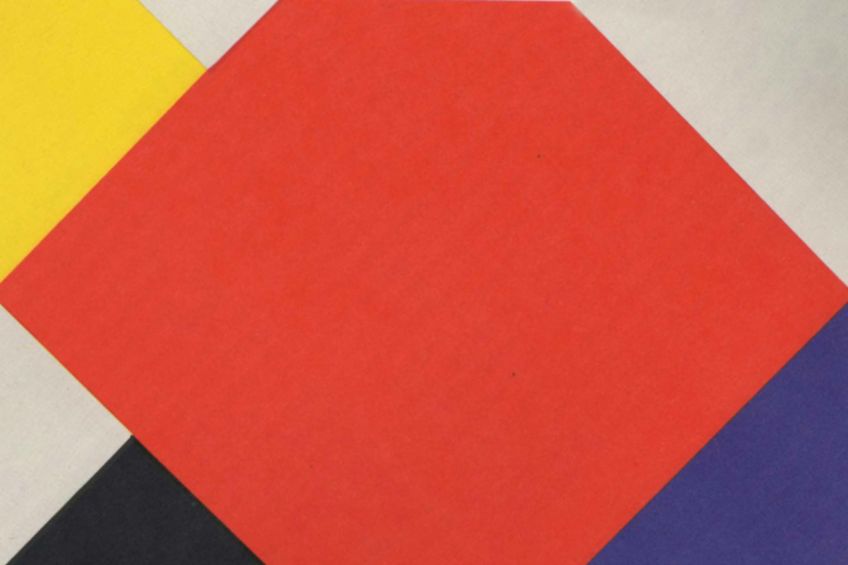De Stijl Art – Discovering the De Stijl Movement
According to the De Stijl art definition, the De Stijl movement was founded by a group of Dutch abstract artists that created an art style centered around strict vertical and horizontal geometry. The De Stijl movement was established in 1917 by two abstract art pioneers, Theo van Doesburg and Piet Mondrian, and began as a publication. This publication became an outlet for Mondrian’s views on art, and in a number of essays in the magazine’s early editions, he talked about what he wanted to achieve and used the word “neoplasticism”, possibly for the first time. In today’s article, we shall be exploring De Stijl art, De Stijl architecture, De Stijl painting, and important De Stijl artists.
Exploring the De Stijl Movement
Based in the Netherlands, the abstract style of the De Stijl movement centered on fundamental visual components such as the use of basic geometric shapes and primary colors. The more minimalist quality of De Stijl art was envisaged by its designers as a global visual language suited to the contemporary period, an era of a new, spiritualized order of the world, partially in reaction to the ornamental excesses of the Art Deco style. De Stijl artists used this approach in a variety of mediums in both the fine and applied arts.

Members of the De Stijl movement promoted their creative ideas in their publication from which the movement took its name, imagining the ideal synthesis of function and form, thus rendering De Stijl the ultimate style. To achieve this goal, De Stijl artists focused not just on fine art mediums like De Stijl painting and sculpture, but also on nearly every other art form, including typography, industrial design, literature, and music. The movement’s effect was arguably most noticeable in De Stijl architecture, where it contributed to the development of the renowned International Style which rose to popularity in the 1920s and 1930s.
The Important Ideas of the De Stijl Movement
De Stijl, which translates to “the style” in Dutch, originated primarily as a reaction to the tragedies of World War I and an urge to reconstruct society in its wake, as did other avant-garde groups of the period. Members of the De Stijl movement adopted an idealistic concept of art and its transformational power, considering it a method of both social and spiritual restoration. De Stijl artists were among the first to advocate a visual language comprised of perfectly drawn geometric forms – mainly straight lines, shapes such as rectangles and squares, and the use of primary colors. This minimalist language was intended to demonstrate the principles guiding the world’s harmony, reflecting the artists’ yearning for something universal, as individuality began to lose its significance. While De Stijl artists made artwork that embodied the movement’s utopian goals, their conclusion that this ideal was unreachable in the real world led to the group’s dissolution.
In the end, the ongoing reputation of De Stijl is partly due to the accomplishments of its most well-known member, Piet Mondrian.
The Origins of De Stijl Art
Theo van Doesburg launched the modern art periodical De Stijl in 1917 in order to gather like-minded artists for the development of a new creative community that welcomed an expanding vision of art, filled with utopian aspirations of spiritual harmony. The magazine served as the foundation for the De Stijl movement, a Dutch group of painters and architects led by J. J. P. Oud, Piet Mondrian, and Vilmos Huszar. The De Stijl artists wanted to be far more than just visual artists, incorporating certain elements of Suprematism and Cubism, Dada’s anti-sentimentalism, and M. H. J Schoenmaekers’ Neo-Platonic mathematical theory, a mystical philosophy that defined the notion of “ideal” geometric forms. At its fundamental level, De Stijl was intended to include a wide range of artistic media and influences, with the goal of developing a new aesthetic that would resonate not just in the applied and fine arts, but also in everything from architecture to poetry. The De Stijl style and vision arose in large part in response to the exceptional devastation of war, with the movement’s adherents seeking a way to convey order in the new society that would arise in the aftermath of the war.

De Stijl Concepts
The De Stijl artists were not the first to experiment with abstract art as other artists, most particularly Kazimir Malevich, Wassily Kandinsky, and Hans Arp, had already produced nonobjective art, often integrating geometric forms in their paintings. However, the architects and artists associated with De Stijl embraced what they saw as a purer type of geometry, involving various forms produced out of basic geometric shapes and straight lines. Along with the incorporation of pure primary colors, these motifs offered the basic components for compositions that stayed away from symmetry in preference for a balanced relationship between color distribution and surfaces. Mondrian once stated that De Stijl art would convey itself in an aesthetically cleansed, or abstract form, as a pure depiction of the human intellect.
As a result, the new plastic concept could not take the form of a tangible or natural portrayal.
Neo-Plasticism
The painting style and principles created by Piet Mondrian in 1917 and championed by De Stijl are referred to as Neo-Plasticism. The phrase “new plastic art” symbolizes Mondrian’s concept of an idealized, abstract art form appropriate for the contemporary era. Mondrian’s writings defined the concept and were published in 12 parts in the periodical De Stijl between 1917 and 1918. Mondrian defined Neo-Plasticism as a reductive method to artmaking in which typical aspects of art, such as representation and perspective, were abandoned in favor of a limited palette of primary colors and straight lines.

Mondrian imagined Neo-Plasticism concepts being translated from the medium of De Stijl painting to other art forms, such as De Stijl architecture and design, laying the foundation for the reshaping of the human environment intended by De Stijl artists. Schoenmaekers’ treatise, which suggested that reality is formed of a sequence of opposing forces, including the structural polarity of vertical and horizontal axes and the juxtaposition of basic colors, was a major inspiration for Neo-Plasticism. The style took hold in the United States too, where it was adopted by a number of American abstract painters after Mondrian’s trip there in 1940.
Elementarism
While only vertical and horizontal lines were to be used in Neo-Plasticism, van Doesburg invented Elementarism in 1925, which aimed to change the dogmatic aspect of the style through the introduction of the diagonal, an arrangement that he associated with dynamism – a condition characterized by continuous development. Mondrian, who valued both vertical and horizontal lines for their connotations of stability, greatly disapproved of van Doesburg’s increasing focus on the diagonal–a conflict that famously caused Mondrian to leave De Stijl shortly afterward.
For Mondrian, van Doesburg’s use of the diagonal was tantamount to artistic heresy; the Elementarist diagonal, in his opinion, denied De Stijl’s efforts to perfectly integrate all components of the painting by generating tension between the picture plane and the composition.
Later Developments
Throughout the 1920s, De Stijl architecture, mainly by Oud and Rietveld, was created in the Netherlands, all of which appeared at odds with van Doesburg’s idea of Elementarism, instead adopting distinct vertical and horizontal lines. De Stijl had a significant impact on Bauhaus design and architecture; numerous De Stijl members lectured at the Bauhaus, possibly most notably van Doesburg, who taught there in 1921. De Stijl’s visual geometric language, in addition to architectural ideals like form following function and a focus on structural components, would resonate throughout Bauhaus architectural approach and the worldwide aesthetic known as the “International Style.
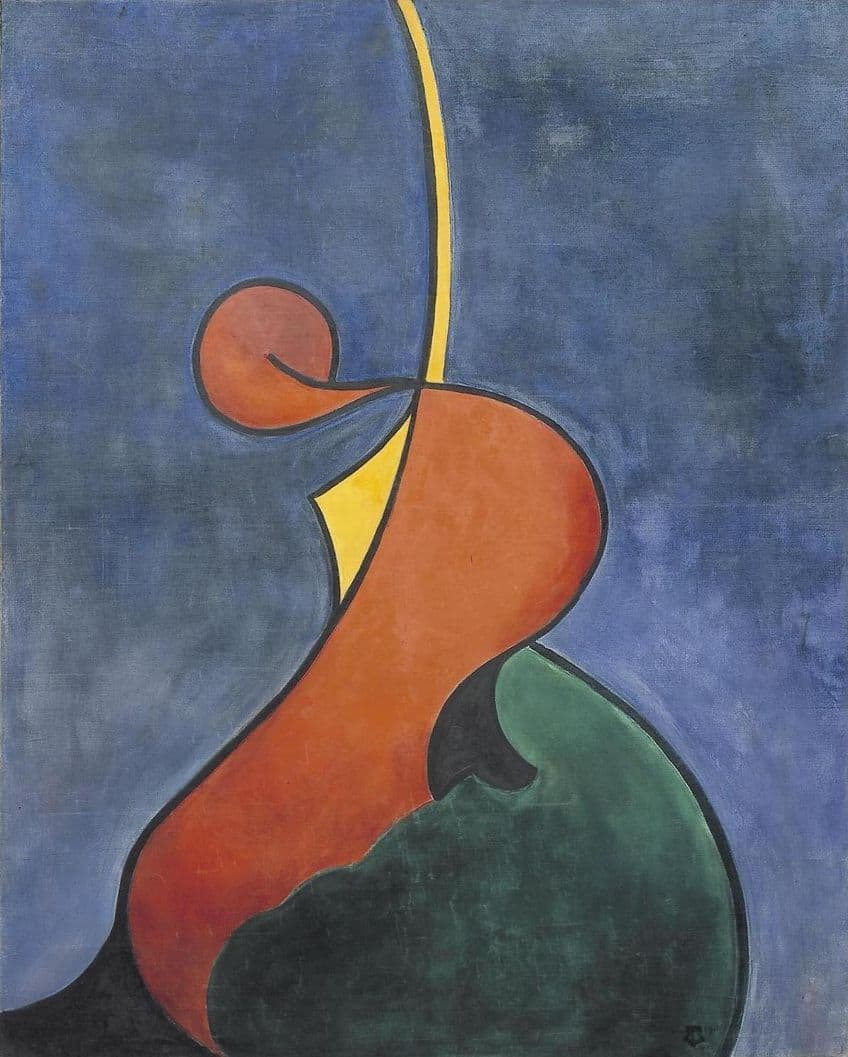
In 1931, De Stijl would lose its leader, Theo van Doesburg, and quickly fell from prominence. Nevertheless, the movement’s primary principles of pure geometric abstraction and the interdependence of function and form were carried on by many after van Doesburg’s death, and they represent an important contribution to modern art, architecture, and design. Several of Rietveld’s structures, for instance, have outlasted the De Stijl movement and inspired numerous 20th-century architects, including Mies van der Rohe. The minimalist De Stijl aesthetic had an impact on many 20th-century and later artists and designers in addition to architecture, including the Abstract Expressionists Barnett Newman and Mark Rothko, the Hard-edge artists Frederick Hammersley and Frank Stella, and the Minimalists Dan Flavin and Donald Judd.
Famous De Stijl Artworks
The objective was not to constantly paint white, red, blue, and yellow rectangles defined with black lines in order to debate their appearance but to capture and transform the experiences that arrive through our eyes into the realm of the cognitive. In other words, De Stijl artist’s artwork was about the blueness of blue and the redness of red, which are unable to be mistaken for one another, and the feelings that their juxtaposition evokes. Thus, De Stijl was akin to narrating a tale or even creating poetry with visual signals, something some of us still find difficult to fathom in this day and age.
Even though the movement ended in 1933, partly owing to Theo van Doesburg’s premature passing and partly because of the socio-political circumstances in soon-to-be Nazi Germany, its legacy persisted.
Let’s explore a few famous De Stijl artworks below. Unfortunately, this movement was exclusively populated by men, and there are no examples of De Stijl artworks by women. While they did not contribute any artworks to the movement, there were a few women connected to the De Stijl members, such as the Dada artist, Nelly van Doesburg, who was also Theo van Doesburg’s wife.
Composition A (1920) by Piet Mondrian
| Artist | Piet Mondrian (1872 – 1944) |
| Date Completed | 1920 |
| Medium | Oil on canvas |
| Location | Galleria Nazionale d’Arte Moderna, Rome, Italy |
Mondrian felt that his abstract compositions were able to communicate a more profound spiritual truth. Through his geometric abstractions, he attempted to communicate the balance and harmony that he observed underlying the physical universe. Mondrian’s art evolved into a visual representation of his spiritual views, representing his vision for an ideal society built on universal order. Mondrian’s work acquired international fame and recognition, especially when he relocated to Paris in the 1920s. His artwork and ideas were widely disseminated through exhibits and publications, attracting a large audience and influencing other artists and designers all around the world.
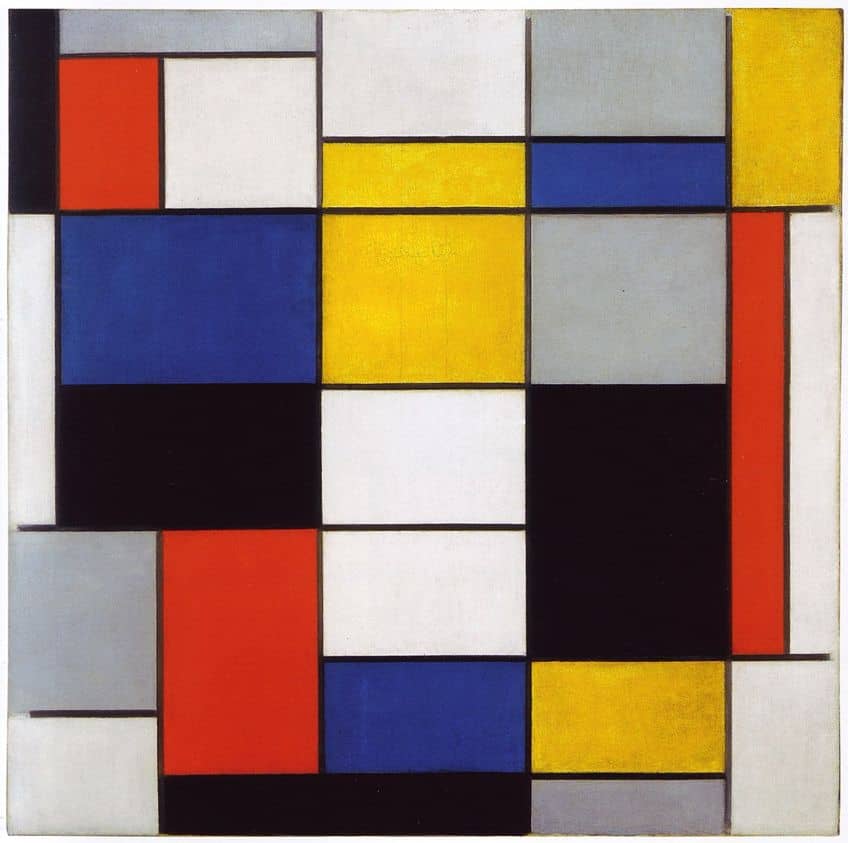
Composition A, whose title reveals its nonobjective character by making no mention of anything outside of itself, is a fine representation of Mondrian’s geometric abstraction prior to its complete maturation within the context of the De Stijl aesthetic. The piece, with its rectilinear shapes composed of solid, delineated sections of color, shows the artist’s engagement with Schoenmaekers’ mathematical theory as well as his desire for a simplified visual language fit for the modern day.
While Mondrian utilized blacks and grays here, his paintings would subsequently become more simplified, utilizing more basic compositions and solid blocks of primary colors.
Mechano-Dancer (1922) by Vilmos Huszar
| Artist | Vilmos Huszar (1884 – 1960) |
| Date Completed | 1922 |
| Medium | Photomontage |
| Location | Private collection, New York, United States |
Huszár’s creative approach was consistent with De Stijl concepts. He developed abstract geometric compositions with clear lines, geometric shapes, and forms reduced to their fundamental constituents. His paintings featured primary colors and non-colors, according to the movement’s Neo-Plasticist ideas. Alongside his paintings, Huszár also made substantial contributions to applied arts and design, both of which were fundamental to the De Stijl movement’s principles. He looked at how geometric abstraction may be used in furniture, graphic design, typography, and architectural aspects. Huszár’s designs sought to merge art into daily life in order to create a harmonious atmosphere.
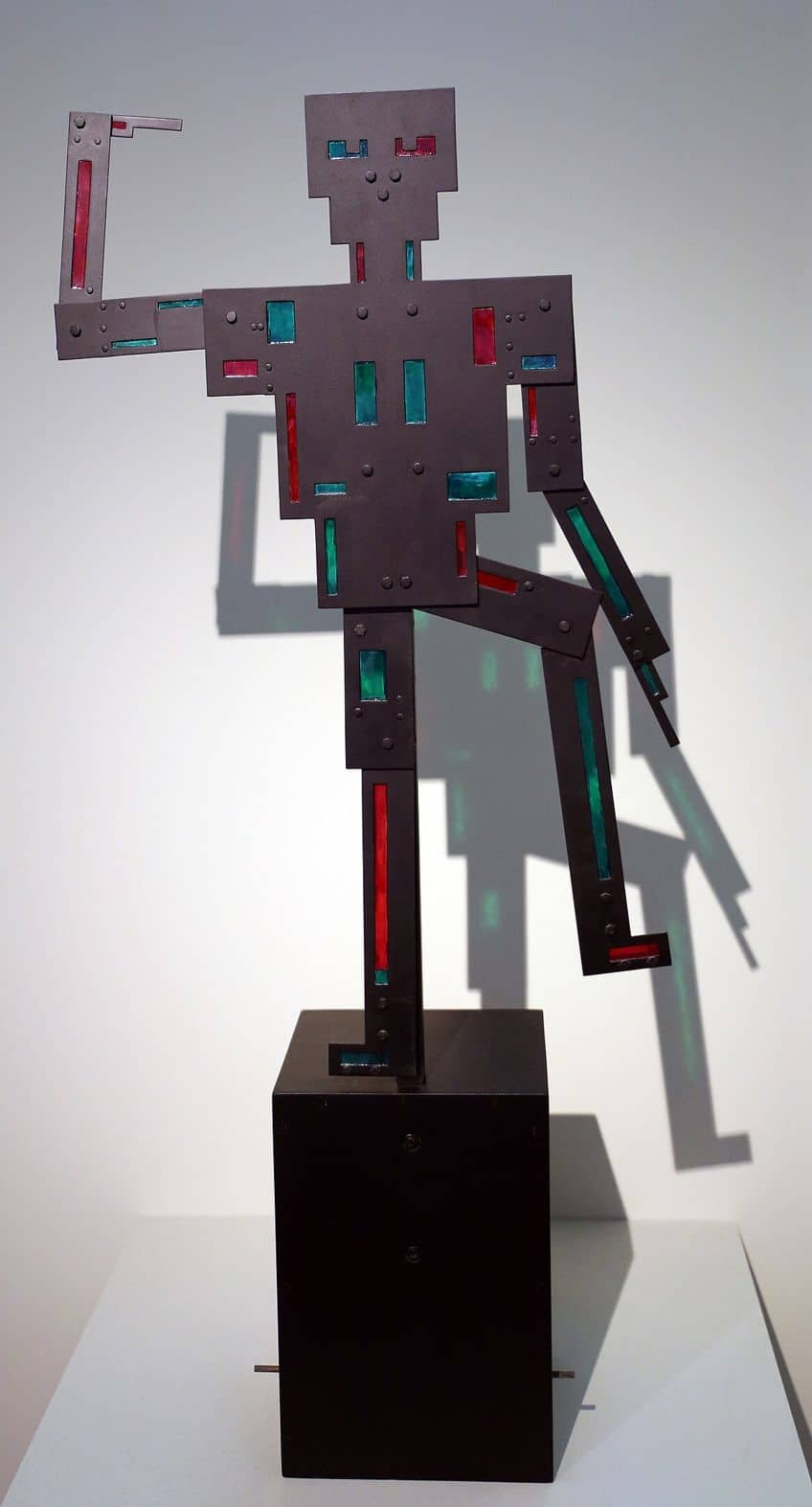
This work employs the De Stijl aesthetic’s signature geometric shapes, but its layering of forms and shapes, the combination of vertical, horizontal, and diagonal lines, and lack of color reflect a different approach than that of De Stijl’s leading artists, Mondrian and Van Doesberg. The work’s representation of a human figure is also uncommon in De Stijl art, achieved by this particular arrangement of the geometric forms and the positioning of a cube at the top, potentially symbolizing a head.
The evocation of a hybrid man-machine, as hinted by its title, reveals the influence of Italian Futurism and Dada.
Red and Blue Chair (1923) by Gerrit Rietveld
| Artist | Gerrit Rietveld (1888 – 1964) |
| Date Completed | 1923 |
| Medium | Painted wood |
| Location | Auckland Museum, Auckland, New Zealand |
By exploring new possibilities in form and space, Rietveld’s works challenged established concepts of architecture and furniture. His art pieces were usually defined by dynamic compositions, asymmetry, and a feeling of visual tension. Rietveld’s design and architectural approach were consistent with the De Stijl movement’s goal of creating harmonious settings through the application of abstract ideas. Red and Blue Chair is one of the movement’s iconic works, having been planned in 1918 but not completely completed until 1923 when it integrated the signature De Stijl palette of primary colors.

Rietveld imagined a chair that interacted with and modified the world around it, made out of planes, rectilinear volumes, and lines that interacted in unexpected ways while avoiding intersections. Every line, color, and plane is sharply defined as if they were separate works that happened to be utilized for furniture. The basic construction used by Rietveld was also deliberate; he made the chair out of standard timber sizes accessible at the period, reflecting his objective of creating an item that could be mass-produced rather than hand-crafted.
Red and Blue Chair emphasizes its manmade quality while also avoiding the usage of natural shapes, which furniture designers prefer to use in order to highlight a sense of physical comfort and ease.
Counter Composition V (1924) by Theo van Doesburg
| Artist | Theo van Doesburg (1883 – 1931) |
| Date Completed | 1924 |
| Medium | Oil on canvas |
| Location | Stedelijk Museum, Amsterdam, the Netherlands |
The Counter Compositions series of De Stijl paintings, introduced for the first time in 1924, represent Van Doesburg’s desire to transcend the constraints of the De Stijl movement with the development of Elementarism. Although he continued to use vertical and horizontal lines, the use of diagonal lines became more of a priority; he defined Elementarism as “centered on the neutralization of both positive and negative directions by the diagonal”.

He decided to call these paintings Counter Compositions, as the compositions’ lines are all at a 45-degree angle to the sides of the painting instead of parallel to them, culminating in a novel and energized interaction between the canvas format and composition therein. He often explored outside of the three primary colors, incorporating a triangle of gray along with the primary colors, as well as white and black, as can be seen in this example. The De Stijl movement was still developing its own distinct voice at the time he created this composition.
Paintings, furniture designs, and architecture created by individuals involved with the movement conveyed how colors and lines should interact, and how the visual appeal of a product is just as important as its purpose.
Rietveld Schröder House (1924) by Gerrit Rietveld
| Artist | Gerrit Rietveld (1888 – 1964) |
| Date Completed | 1924 |
| Medium | Brick, concrete, plaster, wood, steel, and girders |
| Location | Rietveld Schröder House, Utrecht, the Netherlands |
The Rietveld Schröder House is a significant forerunner to the International Style inspired largely by the Bauhaus movement, as well as the only building created entirely in the De Stijl architecture style. Truus Schröder-Schrader commissioned the house in 1924, wanting it to be open-planned and grand, a real statement for how an independent contemporary lady ought to live her life. The structure highlights its architectural features – posts, slabs, and beams – using the usual De Stijl palette of black, white, and primary colors, representing the movement’s focus on construction, form, and function in its design and architecture. In many ways, the design deviates significantly from architectural convention and tradition.
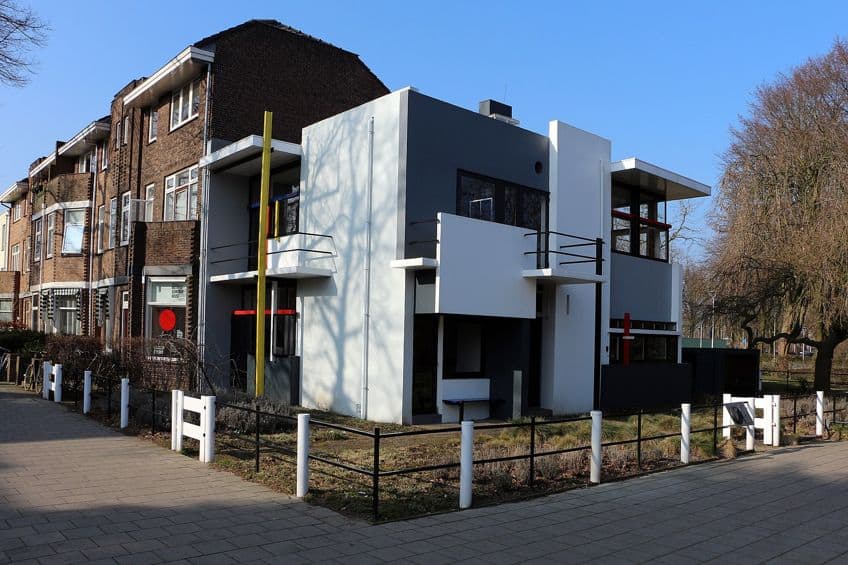
Inside the building, the rooms are designed as moveable units with removable walls. Rietveld’s design also makes little attempt to engage with the neighboring buildings or streets, emphasizing its existence as an isolated building that focuses inward rather than outward. Rietveld’s unique approach to both De Stijl architecture and design had an enduring impact that extended beyond the De Stijl movement. His concepts and creations impacted succeeding generations of architects and designers, both in his own country and abroad. The emphasis on practicality, abstraction of geometry, and the combination of art and design that Rietveld emphasized grew to become significant principles of contemporary design.
That wraps up this article on the De Stijl movement. The movement did not only create De Stijl paintings, as the De Stijl art style was also incorporated into everything from De Stijl architecture, music, literature, and typography. Founded by the Dutch architect and painter Theo van Doesburg in 1917, the movement was most-known for turning away from naturalistic representation to rather focus on a style that was solely comprised of primary colors, rectangular planes, and straight lines. This style arose as a reaction to the turmoil caused by the First World War, with the aim of restoring some sense of balance and order in the daily lives of both the artists and society.
Frequently Asked Questions
What Is the De Stijl Art Definition?
It defines the style of abstraction that was originally pioneered by Theo van Doesburg in his publication, De Stijl (1917). The style is defined by the rejection of realistic depiction in favor of something far more simplified and essential. What characterizes the style most is the use of vertical and horizontal black lines and exclusively primary colors. There was, however, an offshoot style known as Elementarism, that expanded on these ideas by introducing diagonal lines and a more varied color palette.
What Is Neo-Plasticism in De Stijl Art?
Neoplasticism was an important aesthetic concept in the De Stijl art movement. It was created by Theo van Doesburg and Piet Mondrian, among others, and functioned as the guiding concept for De Stijl art’s visual language. The aim of Neo-Plasticism was to develop a new form of art based on universal principles of order, harmony, and abstraction. Its goal was to portray a spiritual and utopian depiction of the universe through the most basic essential forms. It was seen as a significant departure from the traditional forms of representational art, and its intention was that these essential forms could express spiritual truths.
Liam Davis is an experienced art historian with demonstrated experience in the industry. After graduating from the Academy of Art History with a bachelor’s degree, Liam worked for many years as a copywriter for various art magazines and online art galleries. He also worked as an art curator for an art gallery in Illinois before working now as editor-in-chief for artfilemagazine.com. Liam’s passion is, aside from sculptures from the Roman and Greek periods, cave paintings, and neolithic art.
Learn more about Liam Davis and about us.
Cite this Article
Liam, Davis, “De Stijl Art – Discovering the De Stijl Movement.” artfilemagazine – Your Online Art Source. July 21, 2023. URL: https://artfilemagazine.com/de-stijl-art/
Davis, L. (2023, 21 July). De Stijl Art – Discovering the De Stijl Movement. artfilemagazine – Your Online Art Source. https://artfilemagazine.com/de-stijl-art/
Davis, Liam. “De Stijl Art – Discovering the De Stijl Movement.” artfilemagazine – Your Online Art Source, July 21, 2023. https://artfilemagazine.com/de-stijl-art/.


